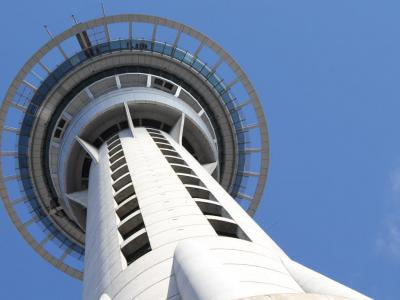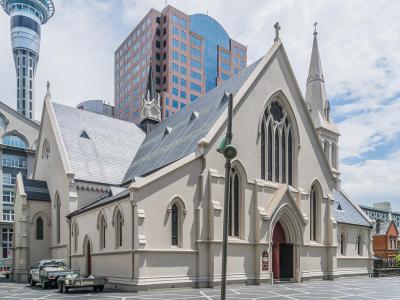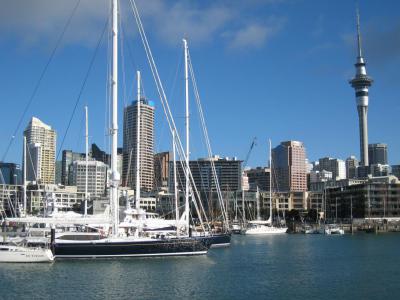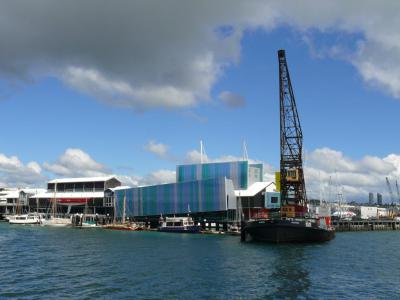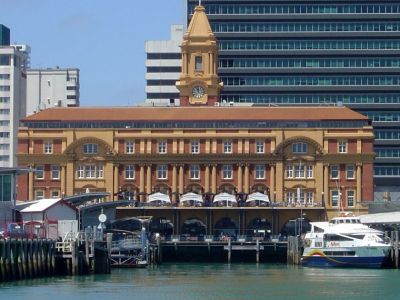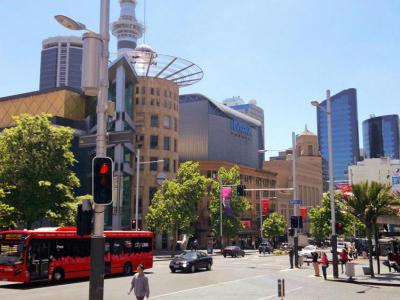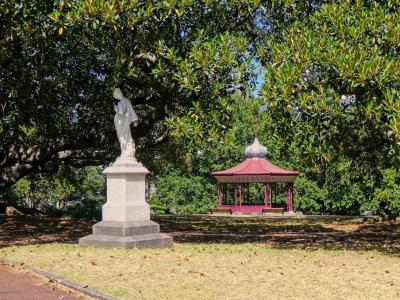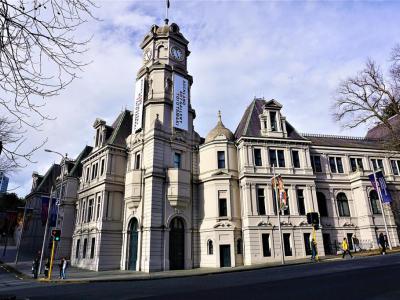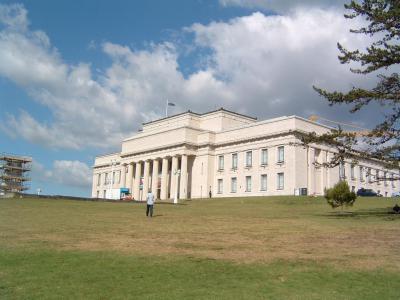
Auckland Introduction Walking Tour (Self Guided), Auckland
Owing to their remoteness, the islands of New Zealand were the last large habitable lands to be settled by humans. Maori began to inhabit this area around 1350 and they called it "desired by many", referring to its abundant natural resources.
In 1840, after purchasing land from the local tribe, the British established Auckland as a colonial settlement. Its first governor, Lieutenant William Hobson, chose the site as the capital of New Zealand.
In its early days, the city's economy was driven by logging and mining industries. Later, dairy farming and manufacturing played a significant role. In recent decades, Auckland has seen a boom in tourism.
The city boasts a number of cultural institutions, such as the Auckland War Memorial Museum and Art Gallery Toi o Tāmaki. There are also many historical sites well worth visiting. Among them is Saint Patrick's Cathedral proudly standing on the same spot since 1841. Another notable attraction is the historic Ferry Building, a live testament to the importance of water transport in Auckland's development since 1912.
And to fully appreciate Auckland's maritime tradition, one should definitely pay a visit to the Viaduct Harbor where high-stake regattas take place. This harbor is also known for its exclusive dining and shopping opportunities.
As for the Auckland region in general, it is renowned for its warm, coastal climate, and is therefore a great place for exploring on foot. To see for yourself, take our self-guided walking tour of the main attractions this beautiful city has to offer!
In 1840, after purchasing land from the local tribe, the British established Auckland as a colonial settlement. Its first governor, Lieutenant William Hobson, chose the site as the capital of New Zealand.
In its early days, the city's economy was driven by logging and mining industries. Later, dairy farming and manufacturing played a significant role. In recent decades, Auckland has seen a boom in tourism.
The city boasts a number of cultural institutions, such as the Auckland War Memorial Museum and Art Gallery Toi o Tāmaki. There are also many historical sites well worth visiting. Among them is Saint Patrick's Cathedral proudly standing on the same spot since 1841. Another notable attraction is the historic Ferry Building, a live testament to the importance of water transport in Auckland's development since 1912.
And to fully appreciate Auckland's maritime tradition, one should definitely pay a visit to the Viaduct Harbor where high-stake regattas take place. This harbor is also known for its exclusive dining and shopping opportunities.
As for the Auckland region in general, it is renowned for its warm, coastal climate, and is therefore a great place for exploring on foot. To see for yourself, take our self-guided walking tour of the main attractions this beautiful city has to offer!
How it works: Download the app "GPSmyCity: Walks in 1K+ Cities" from Apple App Store or Google Play Store to your mobile phone or tablet. The app turns your mobile device into a personal tour guide and its built-in GPS navigation functions guide you from one tour stop to next. The app works offline, so no data plan is needed when traveling abroad.
Auckland Introduction Walking Tour Map
Guide Name: Auckland Introduction Walking Tour
Guide Location: New Zealand » Auckland (See other walking tours in Auckland)
Guide Type: Self-guided Walking Tour (Sightseeing)
# of Attractions: 10
Tour Duration: 2 Hour(s)
Travel Distance: 4.8 Km or 3 Miles
Author: leticia
Sight(s) Featured in This Guide:
Guide Location: New Zealand » Auckland (See other walking tours in Auckland)
Guide Type: Self-guided Walking Tour (Sightseeing)
# of Attractions: 10
Tour Duration: 2 Hour(s)
Travel Distance: 4.8 Km or 3 Miles
Author: leticia
Sight(s) Featured in This Guide:
- Sky Tower
- Saint Patrick's Cathedral
- Viaduct Harbour
- New Zealand Maritime Museum
- Ferry Building
- Queen Street
- Albert Park
- Art Gallery Toi o Tāmaki
- Auckland Domain
- Auckland War Memorial Museum
1) Sky Tower (must see)
The Auckland Sky Tower provides some of the best views over the city and further afield. The structure extends 328 meters up into the air, making it the tallest construction in NZ. From your place at the top, you can look over the city as well as out into the countryside for up to 80 kilometers. Just getting to the top is an experience in itself as you zoom upwards in a glass-paneled lift. There are three different viewing platforms allowing a bird’s eye view of Auckland. The Skywalk offers you the chance to take an adrenaline-filled stroll around a 1.2-meter wide platform at 192 meters above the ground – you are safely strapped into the overhead safety lines, but there’s some extreme exhilaration associated with it.
True adrenaline junkies will leap at the chance to try out a base jump from one of the tallest buildings in the Southern Hemisphere. The wire connected base jump is probably the closest experience to being a bird that there is as you descend 192 meteres to the ground below. New Zealand has a reputation for being the world capital of extreme sports and your heart racing experience can begin in Auckland.
Tip:
If you book dinner, access to the Skydeck is included.
Best time to be up there is before sundown. Give it an hour before.
Alternately, you could get a pass so you can come back the next day. This way, you get to see the view from both day and night.
True adrenaline junkies will leap at the chance to try out a base jump from one of the tallest buildings in the Southern Hemisphere. The wire connected base jump is probably the closest experience to being a bird that there is as you descend 192 meteres to the ground below. New Zealand has a reputation for being the world capital of extreme sports and your heart racing experience can begin in Auckland.
Tip:
If you book dinner, access to the Skydeck is included.
Best time to be up there is before sundown. Give it an hour before.
Alternately, you could get a pass so you can come back the next day. This way, you get to see the view from both day and night.
2) Saint Patrick's Cathedral
From modest beginnings in 1841 to the grand building you see before you today, Saint Patrick’s Cathedral in Auckland has always been the centre of Catholicism in the city. The land that the cathedral is built on was granted by the crown to the city’s first bishop Jean Baptiste Pompallier on June 1st, 1841. A simple wooden structure was first built to serve the 300 odd strong congregation that was mainly made up of Irish immigrants. It was clear that a more substantial building would be required and in 1845 an architect was commissioned to design a stone church. When Auckland was made a diocese in 1848, it was clear that a grander building would be required.
In 1884 the foundation stone was laid for extensive expansions to be made to the church and the old stone church became the transept. A new nave was added that included a bell tower and bells were imported directly from Rome. The new cathedral was officially opened on March 15, 1885 – just before Saint Patrick’s Day. Further expansions were carried out to make more space for the growing city’s congregation at the turn of the 20th century and the church that was completed in 1907 is the very same that you gaze upon today.
In 1884 the foundation stone was laid for extensive expansions to be made to the church and the old stone church became the transept. A new nave was added that included a bell tower and bells were imported directly from Rome. The new cathedral was officially opened on March 15, 1885 – just before Saint Patrick’s Day. Further expansions were carried out to make more space for the growing city’s congregation at the turn of the 20th century and the church that was completed in 1907 is the very same that you gaze upon today.
3) Viaduct Harbour (must see)
The Viaduct Harbour, also known as the Viaduct Basin, is a part of Auckland’s waterfront that was built in the early 20th century. In those days, as sea liners were getting bigger, they were having trouble entering the docks. In order to avoid having to build new wharves or dredge the harbor, the viaduct was built as a way of anchoring the ships out in the deeper waters and then ferrying the goods on smaller ships to the docks. The shipping companies didn’t cooperate and the scheme was a resounding failure. Times have changed and the formerly downtrodden area is now in demand real estate space.
Redevelopment of the Viaduct Harbour area has led to the construction of waterfront view apartment buildings alongside a new dining precinct in the city. There is a prestigious marina in the viaduct that has space for smaller sailing vessels as well as plenty of superyachts. Throughout the year the marina is a focal point for many high-class regattas and even Auckland fashion week events. Visiting the Viaduct Harbour is a wonderful opportunity to see the grand New Zealand maritime tradition in full swing in its modern incarnation, as well as to enjoy some exclusive dining and shopping.
Why You Should Visit:
With an abundance of restaurants & bars, most of them with lovely views, this harbour is one of the prime areas to enjoy a bite to eat or a refreshing kiwi beer.
It is especially atmospheric during summer evenings when both tourists and locals enjoy al fresco dining as the sun sets.
Great boardwalk to walk around and lots of benches to sit and 'people watch'.
Tip:
You can walk as far up as the Harbour Bridge along the boardwalk or just stay central. Walk to the very end and on the way you may view the Americas Cup yachts, fishing trawlers, and the odd multimillion-dollar superyacht.
Redevelopment of the Viaduct Harbour area has led to the construction of waterfront view apartment buildings alongside a new dining precinct in the city. There is a prestigious marina in the viaduct that has space for smaller sailing vessels as well as plenty of superyachts. Throughout the year the marina is a focal point for many high-class regattas and even Auckland fashion week events. Visiting the Viaduct Harbour is a wonderful opportunity to see the grand New Zealand maritime tradition in full swing in its modern incarnation, as well as to enjoy some exclusive dining and shopping.
Why You Should Visit:
With an abundance of restaurants & bars, most of them with lovely views, this harbour is one of the prime areas to enjoy a bite to eat or a refreshing kiwi beer.
It is especially atmospheric during summer evenings when both tourists and locals enjoy al fresco dining as the sun sets.
Great boardwalk to walk around and lots of benches to sit and 'people watch'.
Tip:
You can walk as far up as the Harbour Bridge along the boardwalk or just stay central. Walk to the very end and on the way you may view the Americas Cup yachts, fishing trawlers, and the odd multimillion-dollar superyacht.
4) New Zealand Maritime Museum (must see)
The New Zealand Maritime Museum in Auckland is the largest of its kind in the country. The seas surrounding the archipelago have always held an important place in the hearts and minds of New Zealanders from the times of the earliest settlers. Located on Hobson Wharf, the museum charts the nation’s seafaring history from early Polynesian explorers to modern maritime moments such as involvement in the America’s Cup. There is a wide range of permanent and temporary exhibitions that are open to the public as well as theatrical performances of the Polynesian settlement of the New Zealand archipelago.
The main exhibitions concentrate on: Polynesian, Maori vessels and navigation; European voyages of discovery; Settlement and immigration; Early coastal trading; Whaling and sealing; Modern commercial shipping; Lifeboat, pilotage and coastguard services; Navigation and marine surveying; Maritime art and crafts; Recreation and sporting maritime activities; Maritime trades; Harbour and port history.
In addition to a number of reconstructed or preserved ships in the building itself, the museum also owns a number of vessels that are normally berthed outside of the museum, including the 19th-century steam engine Puke and a floating steam crane from the early 20th century called Rapaki that can be entered and explored during normal museum visits.
Tip:
Try to visit around noon so you can catch the firing of the cannon!
The free guided tours will certainly add color to your visit, too.
The main exhibitions concentrate on: Polynesian, Maori vessels and navigation; European voyages of discovery; Settlement and immigration; Early coastal trading; Whaling and sealing; Modern commercial shipping; Lifeboat, pilotage and coastguard services; Navigation and marine surveying; Maritime art and crafts; Recreation and sporting maritime activities; Maritime trades; Harbour and port history.
In addition to a number of reconstructed or preserved ships in the building itself, the museum also owns a number of vessels that are normally berthed outside of the museum, including the 19th-century steam engine Puke and a floating steam crane from the early 20th century called Rapaki that can be entered and explored during normal museum visits.
Tip:
Try to visit around noon so you can catch the firing of the cannon!
The free guided tours will certainly add color to your visit, too.
5) Ferry Building
The Auckland Ferry Terminal or simply Ferry Building is one of Auckland’s landmark buildings located right in the city’s downtown area. The site known as the Ferry Building is actually comprised of two parts known as the Old and New Buildings. The Old Building is constructed of sandstone in the Edwardian Baroque style and was completed in 1912. The impressive nature of the building demonstrates the importance of water transport in Auckland at the beginning of the 20th century. Originally the building was put to use as a terminal as well as space for the trade unions and consulate offices as well as those of the ferry companies, but in the 1980s it was refurbished and turned into retail space.
In recognition of the importance that the building holds in the growth, development and history of Auckland, it is now registered with the Historic Places Trust. Most of the actual ferry operations have now been moved to the New Building, which has modern piers and appropriate space for the current ferries in use today. The New Building was designed to appear as ships that are anchored behind the original Ferry Building. Auckland is one of the world’s great harbour cities and a stroll through the Ferry Building and a trip out onto the water are a must.
Tip:
Whether or not you're taking a cruise from Auckland, give yourself time to walk around and in this building.
Also, take the time to get yourself a very tasty gelato from the store there and enjoy the view at the harbor.
The outdoor seating facing the waterfront tops the experience off. Public restrooms are a few steps away.
In recognition of the importance that the building holds in the growth, development and history of Auckland, it is now registered with the Historic Places Trust. Most of the actual ferry operations have now been moved to the New Building, which has modern piers and appropriate space for the current ferries in use today. The New Building was designed to appear as ships that are anchored behind the original Ferry Building. Auckland is one of the world’s great harbour cities and a stroll through the Ferry Building and a trip out onto the water are a must.
Tip:
Whether or not you're taking a cruise from Auckland, give yourself time to walk around and in this building.
Also, take the time to get yourself a very tasty gelato from the store there and enjoy the view at the harbor.
The outdoor seating facing the waterfront tops the experience off. Public restrooms are a few steps away.
6) Queen Street (must see)
Queen Street in Auckland’s Central Business District (CBD) is the city’s major commercial center where you can find just about anything and shop ‘til you drop. The main thoroughfare begins down at the wharf area near the Ferry Terminal and extends around 3 km up to Karangahape Road. Although the original town planners envisaged Shortland Street as the city’s main street, it was quickly superseded by Queen Street. Queen Street was surveyed and set down in 1841 immediately following settlement. The swampy area had to be heavily gravelled, but buildings began to pop up along the street almost immediately.
Queen Street further cemented its place as the city’s most important street following a fire along Shortland Street in 1858, which wiped out around 50 buildings. One of the earliest remaining examples of buildings from these times is the facade of the Bank of New Zealand building. In the 1880s horse drawn buses began taking passengers along the street and in 1902 it was the first street in New Zealand to have bitumen and electric trams. Recent refurbishments between 2006 and 2008 have revitalized the street and confirmed its place as one of New Zealand’s premier shopping destination.
Queen Street further cemented its place as the city’s most important street following a fire along Shortland Street in 1858, which wiped out around 50 buildings. One of the earliest remaining examples of buildings from these times is the facade of the Bank of New Zealand building. In the 1880s horse drawn buses began taking passengers along the street and in 1902 it was the first street in New Zealand to have bitumen and electric trams. Recent refurbishments between 2006 and 2008 have revitalized the street and confirmed its place as one of New Zealand’s premier shopping destination.
7) Albert Park (must see)
Albert Park is one of the many beautiful parks that have been set out in Auckland. The tranquil outdoors space is a labyrinth of walking paths leading up to well-tended garden beds and memorials or public artworks. The park was built upon the site of the Albert Barracks in the 1880s, but before European settlement, the park had been where a Maori settlement lay. Around the park, there are many interesting sites including Albert Park House and the Auckland Art Gallery. One of the most popular features of the park is the Victorian fountain, which is one of the oldest fixtures.
There is also a large statue of Queen Victoria, which was made to celebrate the monarch’s 60th jubilee in 1899. There are war memorials including one for the troops who fought in the Boer War of the late 19th century. There is also a floral clock, which was donated to celebrate Queen Elizabeth II’s visit to the country in 1953. Underneath the ground, the earth is hollowed out like Swiss cheese from the many intersecting tunnels that were built by US troops during World War II – these are now boarded up and cannot be entered. Albert Park is a great place to wander on a fine Auckland day to find relaxation as well as see some of the park’s outdoor features.
Why You Should Visit:
If you're wanting a nice secluded takeaway lunch in the central business district, this is the spot.
Tip:
There's a road splitting the park into two sections. One is on a steep slope with large trees dotted around – you can see the CBD here. The southern side continues up the slope before flattening out at the top where you'll see statues and flowers.
There is also a large statue of Queen Victoria, which was made to celebrate the monarch’s 60th jubilee in 1899. There are war memorials including one for the troops who fought in the Boer War of the late 19th century. There is also a floral clock, which was donated to celebrate Queen Elizabeth II’s visit to the country in 1953. Underneath the ground, the earth is hollowed out like Swiss cheese from the many intersecting tunnels that were built by US troops during World War II – these are now boarded up and cannot be entered. Albert Park is a great place to wander on a fine Auckland day to find relaxation as well as see some of the park’s outdoor features.
Why You Should Visit:
If you're wanting a nice secluded takeaway lunch in the central business district, this is the spot.
Tip:
There's a road splitting the park into two sections. One is on a steep slope with large trees dotted around – you can see the CBD here. The southern side continues up the slope before flattening out at the top where you'll see statues and flowers.
8) Art Gallery Toi o Tāmaki (must see)
The main art gallery in Auckland, known as Toi o Tāmaki, boasts an impressive collection of both national and international artwork, making it the most extensive in New Zealand. It frequently hosts exhibitions from around the world. Back in 2009, an American investor named Julian Robertson made headlines by generously donating art valued at a whopping $115 million to the gallery. This generous gift included works by renowned artists like Paul Cezanne, Paul Gauguin, Pablo Picasso, Henri Matisse, Piet Mondrian, Salvador Dali, Georges Braque, Andre Derain, Fernand Leger, Pierre Bonnard, and Henri Fantin-Latour. It was the largest art donation of its kind in the Australasia region.
The gallery itself is housed in a unique building that combines both modern and traditional architectural elements to showcase the art pieces. When you enter the gallery, you'll walk between majestic kauri columns, a type of native tree, and have the opportunity to explore four floors of exhibitions spanning seven centuries of art history. It's not just a place to admire international art; it's also home to the largest permanent collection of New Zealand art right in the heart of Auckland City.
Visitors can enjoy world-class touring exhibitions and immerse themselves in the rich diversity of traditional and contemporary international art. Additionally, friendly and knowledgeable guides are available to lead you on an engaging tour, offering insights into the art, artists, stories, and histories that enrich the gallery's collection.
Tip:
Take the cost-inclusive guided tour – you won't be sorry you did. Afterward, stick around and wander the galleries you missed during the tour.
The gallery itself is housed in a unique building that combines both modern and traditional architectural elements to showcase the art pieces. When you enter the gallery, you'll walk between majestic kauri columns, a type of native tree, and have the opportunity to explore four floors of exhibitions spanning seven centuries of art history. It's not just a place to admire international art; it's also home to the largest permanent collection of New Zealand art right in the heart of Auckland City.
Visitors can enjoy world-class touring exhibitions and immerse themselves in the rich diversity of traditional and contemporary international art. Additionally, friendly and knowledgeable guides are available to lead you on an engaging tour, offering insights into the art, artists, stories, and histories that enrich the gallery's collection.
Tip:
Take the cost-inclusive guided tour – you won't be sorry you did. Afterward, stick around and wander the galleries you missed during the tour.
9) Auckland Domain (must see)
The Auckland Domain is the oldest park in Auckland, covering 75 hectares, making it one of the largest in the city. It's situated in the central suburb of Grafton and includes the entire explosion crater as well as most of the surrounding tuff ring of the Pukekawa volcano.
This park is famous for housing one of Auckland's primary tourist attractions, the Auckland War Memorial Museum, which is prominently located on the rim of the crater (tuff ring). The crater's floor is occupied by several sports fields, encircling the southern part of the cone. On the opposite side of the Museum, you'll find the cricket pavilion and Auckland City Hospital. Moving to the north side of the central scoria cone, you'll discover the Domain Wintergardens, featuring two beautiful glass houses. The fernery has been built within an old quarry within the cone. Additionally, there are duck ponds in the northern area of the explosion crater, which has a small overflow stream to the north.
Among the notable annual events held here are "Christmas in the Park," which has attracted over 200,000 spectators in the past, as well as other popular recurring events like "Symphony under the Stars," the "Lantern Festival," and the "Teddybears Picnic."
Why You Should Visit:
Great place to picnic, walk around, watch cricket, sit in the shade, listen to music in the park or visit the Auckland Museum and the Wintergardens.
Tip:
If you like walking, make a whole day of it by starting in Mount Eden, then going to Newmarket and the Auckland Domain.
During the summer there are loads of events that take place here, so always worth checking if there's anything happening.
This park is famous for housing one of Auckland's primary tourist attractions, the Auckland War Memorial Museum, which is prominently located on the rim of the crater (tuff ring). The crater's floor is occupied by several sports fields, encircling the southern part of the cone. On the opposite side of the Museum, you'll find the cricket pavilion and Auckland City Hospital. Moving to the north side of the central scoria cone, you'll discover the Domain Wintergardens, featuring two beautiful glass houses. The fernery has been built within an old quarry within the cone. Additionally, there are duck ponds in the northern area of the explosion crater, which has a small overflow stream to the north.
Among the notable annual events held here are "Christmas in the Park," which has attracted over 200,000 spectators in the past, as well as other popular recurring events like "Symphony under the Stars," the "Lantern Festival," and the "Teddybears Picnic."
Why You Should Visit:
Great place to picnic, walk around, watch cricket, sit in the shade, listen to music in the park or visit the Auckland Museum and the Wintergardens.
Tip:
If you like walking, make a whole day of it by starting in Mount Eden, then going to Newmarket and the Auckland Domain.
During the summer there are loads of events that take place here, so always worth checking if there's anything happening.
10) Auckland War Memorial Museum (must see)
Auckland War Memorial Museum is one of New Zealand's most important museums and war memorials. Its collections concentrate on New Zealand history (and especially the history of the Auckland Region), natural history, and military history.
The museum building is also one of the most iconic Auckland buildings, constructed in the neo-classicist style, and sitting on a grassed plinth (the remains of a dormant volcano) in the Auckland Domain. The copper and glass dome, as well as the viewing platform–event center underneath it, quickly won the admiration of critics and public, being noted for its undulating lines, which echo the volcanic landscape and hills around Auckland.
The natural history section of the museum is an innovative and vibrant place to visit with a fascinating calendar of events throughout the year. The museum stores a photographic collection of 1.2 million images, and stores and exhibits 1.5 million natural history specimens from the fields of botany, entomology, geology, land vertebrates and marine biology.
There is also an extensive permanent exhibition covering wars, including wars within New Zealand and New Zealand's participation in overseas conflicts. This exhibition is linked to the War Memorial, and shows, for example, models of Maori pā (fortified settlements) and original Spitfire and Mitsubishi Zero airplanes. The Museum holds the largest collection of applied and decorative arts in New Zealand and selections are currently displayed in the Landmarks and Encounters Galleries.
Why You Should Visit:
Great place to sample the history of NZ through the ages. The vista of the port and city skyline from the front door is also one to savor especially during sunset.
Tip:
Try to time your visit to get tickets for the 30-40min Maori Cultural Performance (daily, 11am, 12pm, and 1:30pm (2:30pm avail Nov-Mar)). Pick up the 'What's On' brochure and select the galleries and themed special exhibitions of most interest. Be sure to also pick up a map at the entrance as the layout is a bit confusing.
The museum building is also one of the most iconic Auckland buildings, constructed in the neo-classicist style, and sitting on a grassed plinth (the remains of a dormant volcano) in the Auckland Domain. The copper and glass dome, as well as the viewing platform–event center underneath it, quickly won the admiration of critics and public, being noted for its undulating lines, which echo the volcanic landscape and hills around Auckland.
The natural history section of the museum is an innovative and vibrant place to visit with a fascinating calendar of events throughout the year. The museum stores a photographic collection of 1.2 million images, and stores and exhibits 1.5 million natural history specimens from the fields of botany, entomology, geology, land vertebrates and marine biology.
There is also an extensive permanent exhibition covering wars, including wars within New Zealand and New Zealand's participation in overseas conflicts. This exhibition is linked to the War Memorial, and shows, for example, models of Maori pā (fortified settlements) and original Spitfire and Mitsubishi Zero airplanes. The Museum holds the largest collection of applied and decorative arts in New Zealand and selections are currently displayed in the Landmarks and Encounters Galleries.
Why You Should Visit:
Great place to sample the history of NZ through the ages. The vista of the port and city skyline from the front door is also one to savor especially during sunset.
Tip:
Try to time your visit to get tickets for the 30-40min Maori Cultural Performance (daily, 11am, 12pm, and 1:30pm (2:30pm avail Nov-Mar)). Pick up the 'What's On' brochure and select the galleries and themed special exhibitions of most interest. Be sure to also pick up a map at the entrance as the layout is a bit confusing.
Walking Tours in Auckland, New Zealand
Create Your Own Walk in Auckland
Creating your own self-guided walk in Auckland is easy and fun. Choose the city attractions that you want to see and a walk route map will be created just for you. You can even set your hotel as the start point of the walk.
Auckland Historical Buildings Tour
Auckland, New Zealand may not be known as a historical city, but it does contain some historical buildings all right. These old structures, dating back to the 19th century, reflect the diverse heritage and architectural evolution of the city and are cherished as landmarks.
The Ferry Building, an iconic waterfront edifice, is a fine example of Edwardian Baroque style. Built in 1912, it once... view more
Tour Duration: 2 Hour(s)
Travel Distance: 4.6 Km or 2.9 Miles
The Ferry Building, an iconic waterfront edifice, is a fine example of Edwardian Baroque style. Built in 1912, it once... view more
Tour Duration: 2 Hour(s)
Travel Distance: 4.6 Km or 2.9 Miles
Useful Travel Guides for Planning Your Trip
Souvenir Shopping Guide: 17 Kiwi Things to Buy in Auckland
Although closer than it used to be, courtesy of “The Lord of the Rings” movie trilogy, New Zealand still remains below “Down Under” to many. If you're privileged to visit Auckland, make sure to bring home something memorable to “extend” your trip. Here are some ideas for signature...
The Most Popular Cities
/ view all
